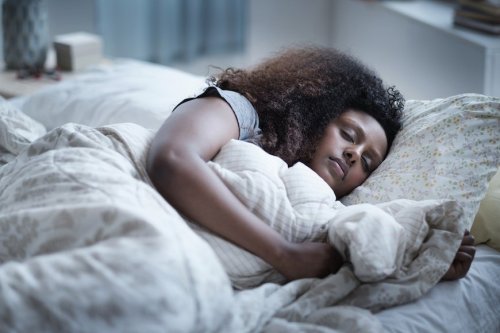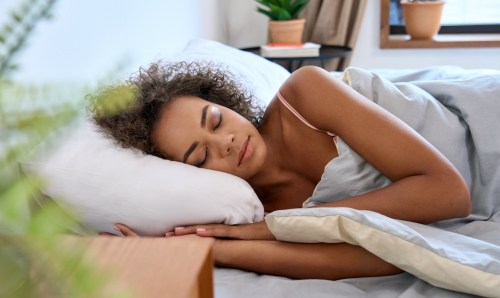How long is a sleep cycle? Plus everything you need to know so you don’t lose anymore sleep over it
A sleep expert answers the question of how long is a sleep cycle and delves into each stage of sleep. Y'know, so you don't lose sleep over it.

Despite being aware of the best sleep hacks available, I still get tripped up about certain terminology and best practices for optimum sleep health. For instance, talk of a circadian rhythm always brings to mind those noisy cicadas, which are very much a different thing. So when I hear something like “sleep cycle” in casual context, it’s easy to wonder things like, “how long is a sleep cycle” and “wait, WTF actually is a sleep cycle?” And, I’ve got a hunch I’m not alone in my confusion.
“The average sleep cycle length is approximately 90 to 120 minutes, depending on the person,” says sleep expert and psychologist Shelby Harris, PsyD. “Healthy adults cycle through approximately five to seven times per night, and during each cycle, there’s various stages of sleep that occur.”
Essentially “various” means four stages of sleep, filed into two categories: non-REM (NREM) sleep REM sleep. REM, as a refresher, stands for rapid-eye movement, and is not to be confused by R.E.M., the Michael Stipe-fronted band. Anyway, the first three stages fall into the first category, whereas the last stage is reserved for REM sleep.
“The average sleep cycle length is approximately 90 to 120 minutes, depending on the person. Healthy adults cycle through approximately five to seven times.” —sleep expert and psychologist Shelby Harris, PsyD.
“During each sleep cycle, we cycle through each stage. The first third of the night’s cycles, though, we spend a greater percentage in deep stage three and four sleep,” Dr. Harris says. “The last third of the night, more time in each cycle is spent in REM sleep, hence having more dreams that we tend to remember later at night and early morning.”
Still confused? Allow us to break down what exactly happens in each sleep cycle.
REM 101: Here’s what to know about each stage of the sleep cycle.
Stage One
In the first cycle, we’re mostly just drifting off. It’s a transitional stage of light sleep that “almost feels like a catnap,” Dr. Harris says. “Your body is relaxing, and it is easy to awaken.” If you’re someone who hits the snooze button on the reg, you’re at best stuck in stage one during those magical nine minute intervals between alarms. (Related: Maybe it’s just time to be a realist and set a later alarm.)
Stage Two
Stage two is for non-rapid-eye-movement sleep (NREM), and is where we spend about 60 percent of our nightly snooze time. “This is really the first true stage of sleep,” Dr. Harris says. “Your breathing and heart rate begin to slow down, and muscles relax further.” Also very cool? Your body temperature tends to lower during this stage. The phenomenon, referred to as thermoregulation, is meant to help us conserve energy while directing it to different parts of the body.
Stage Three
This stage is really all about restoration. “This is when your body is repairing itself and the growth hormone is released,” Dr. Harris says. The good news is that the growth hormone acts to relieve your body from the stresses of the day (thanks, growth hormone—you’re a peach) and the immune system works to heal what ails you. The bad news is that during this phase, you can experience different kinds of parasomnia sleep disorders. “It is hard to wake up from this stage of sleep, and it is often when clumsy sleepwalking episodes tend to occur,” Dr. Harris says. Also let’s not forget sleep-talking, bed-wetting, and night terrors.
Stage Four/REM Sleep
At long last, here is when we enter deep REM, the most phantasmagorical sleep phase of them all (and my personal fave). During REM sleep, our eyes make rapid movements, and our dreams run wild. “This is when you have more intense dreams—you can dream in any stage though, just more so in REM,” Dr. Harris says.
What’s even more fascinating is that while you’re in REM sleep, your mind is painting a picture of feelings and experiences to retain. “Memories are formed, emotions are crystallized during this stage,” she says. “It is active sleep for the brain. I think of it like a filing cabinet that’s trying to figure out what to remember and consolidate, and what to shred during this time of sleep.”
Curious about any drawbacks of REM sleep (because stage three clearly had some bummer disadvantages)? Here’s something interesting: During REM sleep, all of our voluntary muscles besides our eye muscles act as though they’re paralyzed. But in practice, that’s a really just a generous move on REM sleep’s part, because otherwise, we might be provoked to reenact whatever is going on in our dreams IRL.
So, to sum things up (so no one loses any sleep over it): Sleep cycles last an hour and a half to two hours, are broken into four-ish stages, and REM sleep is the best one. Thank you, and good night.
Getting in touch with your inner sleep spirt animal is the best way to time out your workouts, meals, and, well, anything else. And in case you’re curious, this is why you keep have sex dreams about your boss, your friends, and other people you don’t actually want to sleep with.
Sign Up for Our Daily Newsletter
Get all the latest in wellness, trends, food, fitness, beauty, and more delivered right to your inbox.
Got it, you've been added to our email list.










